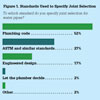
Last fall, as part of its Back to Basics series, PM Engineer ran an extensive feature article in Oct. 2007 called “Joint Selection For Interior Water Pipes.” Because the article was very well received, PME then decided to survey its readers about their design practices concerning pipe joining methods. This article provides and analyzes the results of that survey.
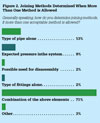
We sent questionnaires to 1,600 of our readers and 23% responded. In the area of marketing surveys, 23% is outstanding. Usually, a response of 3% is considered to be very successful. So, again, thank you for your response and involvement in the industry. (Please see the link at the bottom of this article for a breakdown of respondents’ job titles and classifications.)
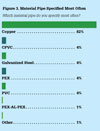
What We Asked
This survey encompassed 15 questions [multiple choice or sliding scale] broken up into three sections. Section one focused on standard followed and basic method determination; section two on specific method and material specified; and section three on factors related to joining (expansion/contraction, bending, components used).The first question we asked was: When designing a water distribution system, do you specify joining methods for interior water pipes? A whopping 98% of those responding gave an affirmative answer. We expected a very high response, but were a little surprised at the 98% figure.
For those who did specify joining methods, we wanted to know which standard they used most often for joint selection (see Figure 1). Based on our survey, the plumbing code is the most-preferred standard (52%) by a large margin. The next most popular choice is ASTM and similar standards (27%), followed by engineered design (17%).

According to our survey, a majority of readers weigh a number of factors before determining which joining method is best. Question three (Figure 2) addressed this topic specifically, by asking: Generally speaking, how do you determine joining methods, if more than one acceptable method is allowed?
Nearly three-fourths of respondents (71%) said they weigh a combination of several elements rather than just one specific factor. Those that did emphasize one factor did so in the following order: type of pipe alone (13%), expected pressure in the system (9%), other (3%), and possible need for disassembly and type of fittings alone (2% each).
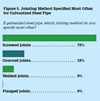
Methods and Materials
Section two focused on specific methods and materials specified. Question four asked: Which material pipe do you specify most often (Figure 3)? The options were copper (82%), CPVC (4%), galvanized steel (4%), PEX (4%), PVC (4%), PEX-AL-PEX (1%) and other (1%).Question four also had two subquestions. The first asked designers which jointing method they specified most often for copper pipe (Figure 4). A whopping 83% selected soldered joints. In descending order came brazed joints (9%), press connect joints (5%) and five methods at 1% or less (compression, flared, grooved, mechanically formed, and lead-free soldered).
The other question asked about their preferred jointing method for galvanized steel pipe (Figure 5). Four options were given, and readers responded as follows: screwed joints (73%), grooved joints (18%), welded joints (9%) and flanged joints (0%).
Next, we asked readers which specific plastic pipe material they specify most often (Figure 6). Nearly half (46%) said PVC. Exactly 30% selected CPVC, followed by 19% for PEX. A small percentage (5%) selected PEX-AL-PEX, PP or PE.
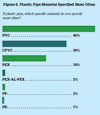
Then we asked about CPVC pipe. The results were very similar, with solvent cementing again being the overwhelming preferred method (89%). Heat fusion increased a bit in popularity to 7%, while screwed schedule 80 and larger moved up to 4%.
Next, we wanted to know about preferred joining methods for PEX pipe. Nearly half of readers said crimp-type fittings (48%). About one-fourth said mechanical connectors and fittings (26%) and bronze fittings [with press connection] (24%). Other received 2%, including a mention for expanding tool fittings.
To close section two, we wanted to know the same information for PEX-AL-PEX pipe. The results were similar to those for PEX pipe. Exactly half (50%) preferred crimp-type fittings, while one-third chose mechanical connectors and fittings (33%). Bronze fittings [with press connection] again was third, but at only 17%.

Related Factors
Section three encompassed four questions. First, we were interested in learning how often you factor in piping expansion and contraction when determining the proper joining method (Figure 8). Our survey said that 41% always factor in expansion/contraction - but 34% do so only when necessary, in special situations. Half that amount (17%) factor in expansion/contraction some of the time. A small percentage say they never consider it (4%) or haven’t needed to consider it (4%).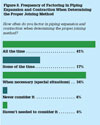
As a follow-up question, we wanted to know which type of system readers preferred when installing flexible plastic pipe: manifold or straight pipe. The vast majority chose manifold (68%) over straight pipe (32%).
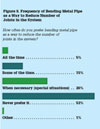
I’m sure you would agree that this was another fascinating survey. If you received the survey questionnaire and responded, our thanks for helping out. If you did not receive a questionnaire, keep an eye on your mail for the next survey. When you get it, take a few minutes to fill it out and send it in. You can help contribute to our next article.